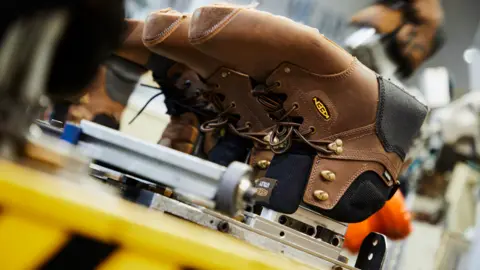In recent developments, the question of whether trainers can be manufactured in the United States without relying on inexpensive labor has prompted significant discussions in both economic and manufacturing circles. A recent move by the family-owned shoe company Keen highlights these concerns as it opens a new factory in Kentucky, demonstrating a commitment to American manufacturing amid ongoing debates about labor costs and automation. This initiative aligns neatly with the “America First” vision promoted during the Trump administration, aiming to revitalize a sector that has long faced challenges.
Keen’s new facility marks a notable shift, yet it is emblematic of the complicated reality of contemporary manufacturing in the U.S. Despite the factory’s opening, it operates with only 24 employees, primarily leveraging advanced automation technology to streamline production processes. Keen’s Chief Operating Officer, Hari Perumal, emphasizes that modern manufacturing is far from the labor-intensive operations of the past. With labor costs in the U.S. being approximately 10 to 12 times more expensive than in Asian countries, Keen’s dependence on automation reveals a necessity for innovation if domestic production is to be sustainable.
This transition has not been straightforward. Such changes began for Keen back in 2010, spurred by rising production costs in countries like China. Keen’s decision to produce domestically provides a buffer against potential tariffs while illustrating the complexities associated with reshoring manufacturing. Still, it raises concerns regarding the overall structure of the footwear industry, where a significant portion of shoe production remains tied to global supply chains. Currently, 99% of shoes sold in the U.S. are imported, revealing the daunting challenge faced by companies like Keen.
In order to make domestic production viable, Keen has heavily invested in automated technologies, allowing its Kentucky plant to function efficiently with a minimal workforce compared to traditional overseas facilities. Perumal stated, which implicitly acknowledges the growing reliance on technology within the sector, “We are making products here in the USA very economically and very efficiently.” The focus has shifted not only to automation but also to strategic design and material sourcing.
Challenges do not end with Keen. Other major footwear brands such as Nike and Adidas have attempted to introduce new manufacturing technologies in the U.S., largely to no avail. Unfortunately, Keen presently assembles just 9% of its shoes in America, a testament to the significant hurdles that remain in overcoming decades of entrenched practices in global manufacturing.
The broader narrative of American manufacturing reflects a remarkable arc since World War II, characterized by an initial boom that helped establish a robust middle class. However, as globalization took hold in the latter part of the 20th century, many industries relocated to seek cheaper labor and looser regulations, resulting in significant contraction in the U.S. manufacturing base. The shoemaking industry serves as a poignant symbol of these transformations, with the vast majority of production now flowing from countries like China, Vietnam, and Indonesia.
For other companies like Oka Brands, an exception to the trend as a domestic shoe producer based in Georgia, the struggle remains palpable. CEO Pepper Harward articulates the difficulties tied to sourcing materials in a fractured industry, stating, “It’s not a self-sustained ecosystem.” To accommodate their production needs, Oka Brands has innovatively tapped into the automotive supplier network for components, revealing the necessity for creative solutions in an environment where traditional supply chains are not readily available.
Both Keen and Oka operate within a complex landscape where the future of U.S. manufacturing stands precarious. While there is increased interest in local production fueled by tariffs and pandemic-related disruptions, experts, including Harward, express skepticism regarding the likelihood of a massive return to domestic manufacturing. He estimates that it might take around a decade of sustained tariffs for manufacturers to consider relocating a significant portion of production back to the U.S. – a scenario that remains uncertain.
For Keen, the new factory represents a long-term vision of reinvestment that is rooted in the company’s values—an approach that emphasizes patience over immediate results. This strategy underscores a possible pathway for the future of manufacturing in the United States, one that embraces technological innovation while remaining cognizant of the historical shifts brought about by globalization. As the U.S. navigates this evolving landscape of manufacturing, Keen’s bold step further illustrates that the intersection of technology and tradition might just be the key to sustaining American industry in the years to come.



